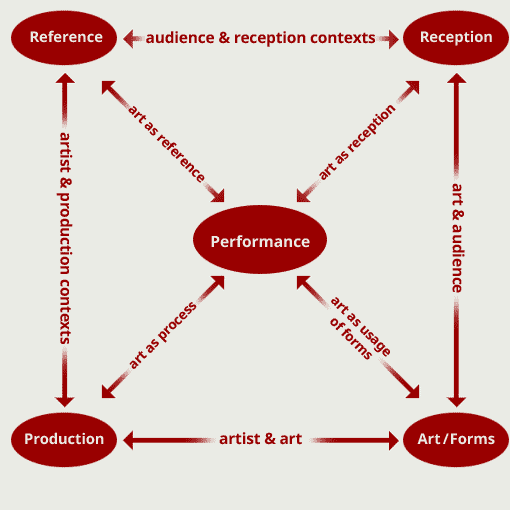Database
 (i) Data is collected and written on the live performance event, not on the video-recording of it collected in the archive. Since the scope of the data is knowledge about one instance of historically and culturally embedded practices, the data entries are detailed, and include descriptive values and some degree of interpretation. The data is intended to supply contextual information from the ground level of theatre practice to the understanding of the videos and scripts.
(i) Data is collected and written on the live performance event, not on the video-recording of it collected in the archive. Since the scope of the data is knowledge about one instance of historically and culturally embedded practices, the data entries are detailed, and include descriptive values and some degree of interpretation. The data is intended to supply contextual information from the ground level of theatre practice to the understanding of the videos and scripts.
(ii) There are four parallel databases in English, Chinese, Japanese and Korean, that is, each entry has its equivalent in three other languages. Data entries are drafted and revised in an interactive process between editors in the four languages.
(iii) The set of data entries for a production serves as a starting point for exploring it, and does not contain a comprehensive fact sheet, nor explanatory material other than a brief gloss for foreign words. Its objective is to make the individual profile of a production visible through information on its creators; on the artistic choices that mark its uniqueness; on where to find responses that define its significance for its audiences; and on its relationships to contextual reference points.
(iv) Categories and sub-categories in Art/Forms were derived empirically after completing individual sets of data for 52 productions, and comparing common factors in their distinctive usage of performance forms and staging strategies. Data categories in Points of Reference will be revised in the same way. The archive supports comparative research into categories in the database through its Pie charts software.
1) Production. Information on the creation of the performance event, including the roles of individuals and organisations, and production dates and venue(s).
2) Reception. Responses to the event by different communities of spectators, defined by the type of publication, its language, medium, and place; including self-evaluations and awards won by the artists.
3) Art / Forms. The microcosm of art; that is, the forms and languages employed, and ways in which existing vocabularies are used distinctively; staging strategies that set the production apart.
4) Points of Reference. The macrocosm of the world, that is, the contexts to which the production refers, both in Shakespeare’s plays and outside Shakespeare; including related productions.
Each category represents a direction from which the performance can be understood; together, they make up the field of discussion surrounding each performance.
The objective of the A|S|I|A database is to collate detailed information on Shakespeare-related performances produced in East and Southeast Asia from the turn of the twenty-first century onwards.
Data Policies and Practices
 (i) Data is collected and written on the live performance event, not on the video-recording of it collected in the archive. Since the scope of the data is knowledge about one instance of historically and culturally embedded practices, the data entries are detailed, and include descriptive values and some degree of interpretation. The data is intended to supply contextual information from the ground level of theatre practice to the understanding of the videos and scripts.
(i) Data is collected and written on the live performance event, not on the video-recording of it collected in the archive. Since the scope of the data is knowledge about one instance of historically and culturally embedded practices, the data entries are detailed, and include descriptive values and some degree of interpretation. The data is intended to supply contextual information from the ground level of theatre practice to the understanding of the videos and scripts.
(ii) There are four parallel databases in English, Chinese, Japanese and Korean, that is, each entry has its equivalent in three other languages. Data entries are drafted and revised in an interactive process between editors in the four languages.
(iii) The set of data entries for a production serves as a starting point for exploring it, and does not contain a comprehensive fact sheet, nor explanatory material other than a brief gloss for foreign words. Its objective is to make the individual profile of a production visible through information on its creators; on the artistic choices that mark its uniqueness; on where to find responses that define its significance for its audiences; and on its relationships to contextual reference points.
(iv) Categories and sub-categories in Art/Forms were derived empirically after completing individual sets of data for 52 productions, and comparing common factors in their distinctive usage of performance forms and staging strategies. Data categories in Points of Reference will be revised in the same way. The archive supports comparative research into categories in the database through its Pie charts software.
Database Structure
The A|S|I|A database organises information on a production according to four main categories of data:1) Production. Information on the creation of the performance event, including the roles of individuals and organisations, and production dates and venue(s).
2) Reception. Responses to the event by different communities of spectators, defined by the type of publication, its language, medium, and place; including self-evaluations and awards won by the artists.
3) Art / Forms. The microcosm of art; that is, the forms and languages employed, and ways in which existing vocabularies are used distinctively; staging strategies that set the production apart.
4) Points of Reference. The macrocosm of the world, that is, the contexts to which the production refers, both in Shakespeare’s plays and outside Shakespeare; including related productions.
Each category represents a direction from which the performance can be understood; together, they make up the field of discussion surrounding each performance.
